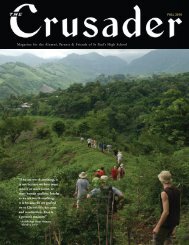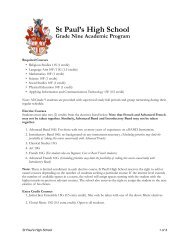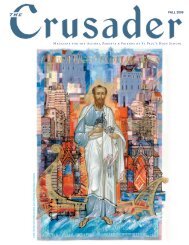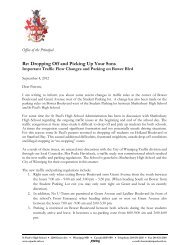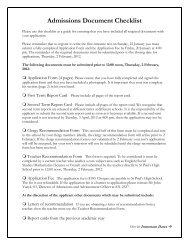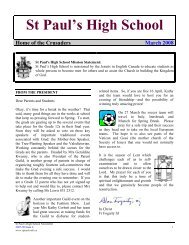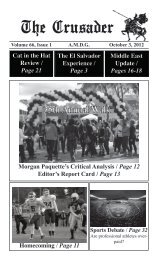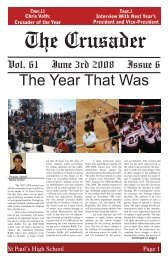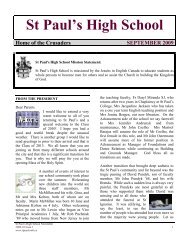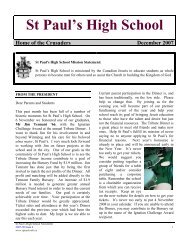The Crusader - Fall 2011 September 20, 2011 - St Paul's High School
The Crusader - Fall 2011 September 20, 2011 - St Paul's High School
The Crusader - Fall 2011 September 20, 2011 - St Paul's High School
Create successful ePaper yourself
Turn your PDF publications into a flip-book with our unique Google optimized e-Paper software.
FEATURE STORY<br />
400 th Anniversary<br />
ofJesuits in Canada<br />
“ It is according to our divine calling to travel to various places and to live<br />
in any part of the world where there is hope of God's greater service and<br />
the help of souls,” —<strong>St</strong> Ignatius Loyola, Society of Jesus Founder<br />
On 22 May 1611, French Jesuit Fathers Ennemond Massé<br />
and Pierre Biard landed at the small trading post of Port Royal,<br />
Nova Scotia which started off a rich history of Jesuit culture<br />
in Canada that led to important contributions to Canadian<br />
history.<br />
<strong>The</strong> “Blackrobes”, as they came to be called, immediately began<br />
to reach out to the indigenous people of the vast new land. <strong>The</strong><br />
Jesuits spread across Eastern Canada scouring three thousand<br />
miles along the Great Lakes and on to the prairies as far as Lake<br />
Winnipeg. <strong>The</strong>y went first to the Micmacs, next to the<br />
Montagnais, then to the Algonquins. <strong>The</strong>y followed the wanderers.<br />
<strong>The</strong>y made their way into the forests, along the waterways,<br />
across the portages and through the woods. To some, these<br />
early Jesuits seemed like adventurers on the frontiers spreading<br />
Christianity to the ‘savages,’ forgetting that in the early Jesuit<br />
Missions, <strong>St</strong> Jean de Brébeuf and his companions in Huronia<br />
appreciated the natives’ rich culture. Brébeuf once wrote: “I have<br />
never met anyone of those who have come to this area, who does<br />
not frankly admit that the native people are quicker of mind<br />
than our ordinary country people.” Among his pastoral work<br />
with the natives, Brébeuf wrote a dictionary of the Huron language<br />
and Canada’s first Christmas carol—“<strong>The</strong> Huron Carol,”<br />
or “Jesous Ahatonhia”—in the native language of the<br />
Huron/Wendat people.<br />
By 1635, the Jesuits had also established at Quebec the celebrated<br />
boys’ school in which they would teach for some 140 years.<br />
<strong>The</strong>ir cours classique would become a model for many other<br />
Catholic colleges, and eventually the Collège des Jésuites would<br />
evolve into Laval University, the oldest institution of higher<br />
learning in North America. By 1760, three-hundred and thirty<br />
Jesuits had come. <strong>The</strong>ir effort in New France, both in missionary<br />
activity and in education, is unmatched. But like the whole<br />
of the grande épopée, it was doomed. After the British<br />
Conquest, they were not allowed to accept novices. <strong>The</strong>y died<br />
out. <strong>The</strong> last was Jean-Joseph Casot, who had come in 1757 and<br />
who died at Quebec, March 16, 1800.<br />
<strong>The</strong> Jesuits returned to Canada in 1842 at the request of Bishop<br />
Ignace Bourget of Montreal and, like their predecessors two<br />
centuries earlier, they came from France. Again, like their predecessors<br />
they spread rapidly. In fact, their story began to unfold<br />
very much as did that of the Catholic Church in Canada. <strong>The</strong>y<br />
incorporated and grew strong in French Canada, travelled to the<br />
indigenous peoples, and followed the large numbers of Catholic<br />
immigrants who settled in Upper Canada and later on the<br />
Western prairies.<br />
Beyond work among the First Nations, the Jesuits were establishing<br />
celebrated educational institutions in Canada, much like<br />
they had already done in Europe. In 1940 there were seven<br />
French-speaking, five English-speaking and two bilingual colleges<br />
as well as six English high schools started by the Jesuits in<br />
Canada. <strong>The</strong> Jesuits’ Ratio <strong>St</strong>udiorum, (the Jesuit Plan and<br />
Method of <strong>St</strong>udies), eventually became the model for 12 Jesuit<br />
colleges and 15 Jesuit high schools spread across Canada—<br />
from <strong>St</strong> John’s to Edmonton.<br />
For the early Jesuits these schools were not simply exercises in<br />
learning but communities where all inquiry led to a reverence for<br />
the creation of God and a fuller understanding of the God of<br />
creation. All knowledge became part of God’s word, an insight<br />
into the humanity of Christ, and the foundation for a society<br />
of humane learning and professional competence.<br />
In 1926, at the invitation of Archbishop Alfred A Sinnott, the<br />
Oblate Fathers opened the first English Catholic <strong>High</strong> <strong>School</strong><br />
for boys in the Province of Manitoba—<strong>St</strong> Paul’s <strong>High</strong> <strong>School</strong>.<br />
Initially located on Selkirk Avenue the building soon became<br />
inadequate and the school moved to the corner of Ellice and<br />
Vaughan at which point the Jesuit Fathers of the Province of<br />
Upper Canada assumed ownership with a staff of four Jesuits,<br />
four lay teachers and eight diocesan priests. With Fr Holland as<br />
the first Jesuit rector, the school had about <strong>20</strong>0 students in attendance.<br />
In 1964, the deteriorating property was replaced by the<br />
construction of the present high school in South Winnipeg.<br />
1 2 <strong>Crusader</strong> <strong>Fall</strong> <strong><strong>20</strong>11</strong>



